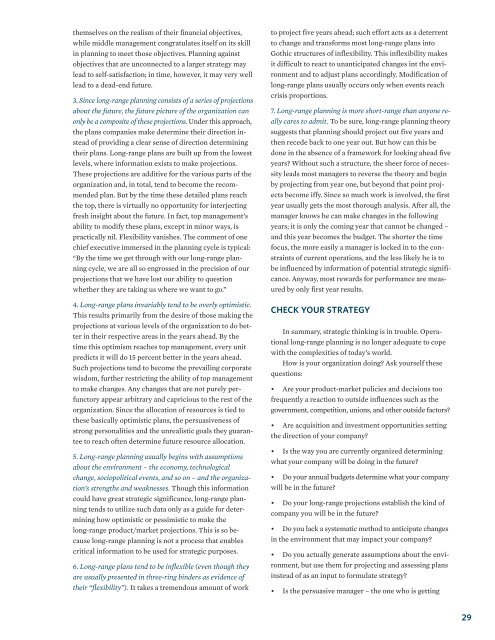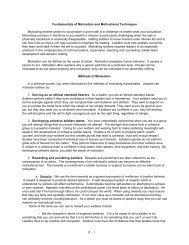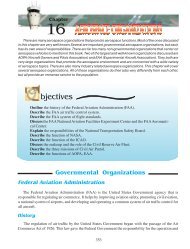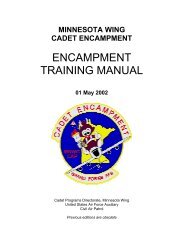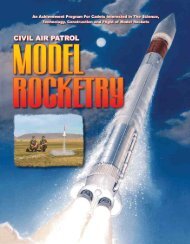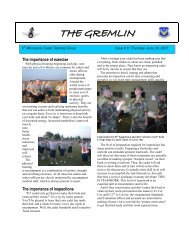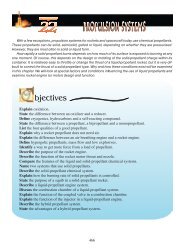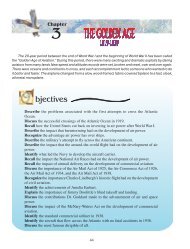The late W. T. Grant Company is a recent, vivid exampleof the bottom right quadrant of the chart. It was aloser because it did not have a clear idea of what it shouldbe in the future and had inadequate operations plans. Thefollowing commentaries from Business Week attest toGrant’s lack of direction:Worse yet, early on Grant seemingly could not makeup its mind what kind of store it was. “There was a lotof dissension within the company whether we shouldgo the K Mart route or go after the Ward and Penneyposition,” says a former executive. “Ed Staly and LouLustenberger were at loggerheads over the issue, withthe upshot being we took a position between the twoand that consequently stood for nothing.”In addition to its lack of direction, Grant’s day-to-dayresults suffered from ineffective operations:From 1963 to 1973 Grant opened 612 stores and expanded91 others, with the bulk of the increase startingin 1968 under the guidance of president RichardW. Mayer and chairman Edward Staley. “The expansionprogram placed a great strain on the physical andhuman capability of the company to cope with theprogram,” says Chairman James G. Kendrick. “Thesewere all large stores – 6 million to 7 million squarefeet per year – and the expansion of our managementorganization just did not match the expansion of ourstores.” Adds a former operations executive: “Ourtraining program couldn’t keep up with the explosionof stores, and it didn’t take long for the mediocrity tobegin to show.”In the upper left quadrant, Sears, Roebuck & Companyis typical of a “winner.” With a clear image of what itshould be in the future, it has also been eminently successfulin its operations. While Sears has had its share of troublerecently, over the years it has consistently demonstratedthe ability to anticipate needed changes in direction andto organize quickly and efficiently in order to make thosechanges.The majority of organizations probably fit in the othertwo quadrants of the chart. For example, many conglomeratescould be placed in the lower left quadrant becausethey are characterized by well defined growth and financialobjectives and ineffective operations. Such organizationstend to see themselves as diverse giants that providea wide range of products and services. However, the carefullythought-out grand scheme has often been marred bypoor operational planning, with resultant over-expansionand inability to manage.The Swiss watch industry is typical of the upper rightquadrant of companies. Superbly efficient at producingand marketing, the industry was overtaken by changes intechnology. The Swiss watchmakers’ strategy was inadequateto help them anticipate external threats to theirsurvival.In the United States, strong operations historicallyhave been more important than clear strategic thinking.In the past, many U.S. organizations survived even whenthey lacked a clear sense of strategic direction. After all,with unlimited resources, skilled labor, and a large, homogeneousmarket, who needed to think much aboutwhat kind of a business they wanted to be in the future?Now, however, with diminishing resources, worldcompetition, and rising costs, even the most efficient operationsmay no longer survive the handicap of operatingwithout a clear, strategic direction. Today’s companymust formulate a clear strategy from which effectiveoperations flow.LONG-RANGE PLANNING: ROADBLOCK <strong>TO</strong>STRATEGIC THINKINGSince strategy provides the framework or picture ofwhat the organization wants to be at some future point intime, it must precede and provide the basis for operationalplanning. Most long-range planning and all shortrangeplanning are operational – they define the “how.”Paradoxically, the real danger to an organization’sstrategic thinking often comes from its own long-rangeplanning. From our research on strategy, conducted inover 200 major American , Canadian, and Europeanfirms, and our strategic-planning consulting with thechief executives of some 75 of these firms, we have seenthat primary emphasis on long-range planning impedesstrategic thinking. It is ironic that the process on whichexecutives rely most heavily to prepare for the future isdoing the most damage, but here is how it happens:1. Long-range planning invariably predicts the organization’sfuture by extrapolation from the present. Projectingfrom current activities straitjackets the future. Startingwith a base of current products and markets makes it difficultto incorporate the new and to eliminate the old inthe light of a changing external environment.2. Theoreticians who urge the establishment of long-rangeobjectives as a starting point for long-range planning fail torecognize this fact: Most managers do not set objectivesthat define their future because they lack a process to assistthem. Without practical tools, managers are forced tobuild their futures on the shaky foundations of the projectionsinstead of on a clear definition of what they wanttheir organizations to be. Where long-range objectives doexist, they are usually set in financial terms. Plans arethen developed down the line and are force-fit into thefinancial constraints imposed by top management. Topexecutives review these plans and then congratulate28
themselves on the realism of their financial objectives,while middle management congratulates itself on its skillin planning to meet those objectives. Planning againstobjectives that are unconnected to a larger strategy maylead to self-satisfaction; in time, however, it may very welllead to a dead-end future.3. Since long-range planning consists of a series of projectionsabout the future, the future picture of the organization canonly be a composite of these projections. Under this approach,the plans companies make determine their direction insteadof providing a clear sense of direction determiningtheir plans. Long-range plans are built up from the lowestlevels, where information exists to make projections.These projections are additive for the various parts of theorganization and, in total, tend to become the recommendedplan. But by the time these detailed plans reachthe top, there is virtually no opportunity for interjectingfresh insight about the future. In fact, top management’sability to modify these plans, except in minor ways, ispractically nil. Flexibility vanishes. The comment of onechief executive immersed in the planning cycle is typical:“By the time we get through with our long-range planningcycle, we are all so engrossed in the precision of ourprojections that we have lost our ability to questionwhether they are taking us where we want to go.”4. Long-range plans invariably tend to be overly optimistic.This results primarily from the desire of those making theprojections at various levels of the organization to do betterin their respective areas in the years ahead. By thetime this optimism reaches top management, every unitpredicts it will do 15 percent better in the years ahead.Such projections tend to become the prevailing corporatewisdom, further restricting the ability of top managementto make changes. Any changes that are not purely perfunctoryappear arbitrary and capricious to the rest of theorganization. Since the allocation of resources is tied tothese basically optimistic plans, the persuasiveness ofstrong personalities and the unrealistic goals they guaranteeto reach often determine future resource allocation.5. Long-range planning usually begins with assumptionsabout the environment – the economy, technologicalchange, sociopolitical events, and so on – and the organization’sstrengths and weaknesses. Though this informationcould have great strategic significance, long-range planningtends to utilize such data only as a guide for determininghow optimistic or pessimistic to make thelong-range product/market projections. This is so becauselong-range planning is not a process that enablescritical information to be used for strategic purposes.6. Long-range plans tend to be inflexible (even though theyare usually presented in three-ring binders as evidence oftheir “flexibility”). It takes a tremendous amount of workto project five years ahead; such effort acts as a deterrentto change and transforms most long-range plans intoGothic structures of inflexibility. This inflexibility makesit difficult to react to unanticipated changes int the environmentand to adjust plans accordingly. Modification oflong-range plans usually occurs only when events reachcrisis proportions.7. Long-range planning is more short-range than anyone reallycares to admit. To be sure, long-range planning theorysuggests that planning should project out five years andthen recede back to one year out. But how can this bedone in the absence of a framework for looking ahead fiveyears? Without such a structure, the sheer force of necessityleads most managers to reverse the theory and beginby projecting from year one, but beyond that point projectsbecome iffy. Since so much work is involved, the firstyear usually gets the most thorough analysis. After all, themanager knows he can make changes in the followingyears; it is only the coming year that cannot be changed –and this year becomes the budget. The shorter the timefocus, the more easily a manager is locked in to the constraintsof current operations, and the less likely he is tobe influenced by information of potential strategic significance.Anyway, most rewards for performance are measuredby only first year results.CHECK YOUR STRATEGYIn summary, strategic thinking is in trouble. Operationallong-range planning is no longer adequate to copewith the complexities of today’s world.How is your organization doing? Ask yourself thesequestions:• Are your product-market policies and decisions toofrequently a reaction to outside influences such as thegovernment, competition, unions, and other outside factors?• Are acquisition and investment opportunities settingthe direction of your company?• Is the way you are currently organized determiningwhat your company will be doing in the future?• Do your annual budgets determine what your companywill be in the future?• Do your long-range projections establish the kind ofcompany you will be in the future?• Do you lack a systematic method to anticipate changesin the environment that may impact your company?• Do you actually generate assumptions about the environment,but use them for projecting and assessing plansinstead of as an input to formulate strategy?• Is the persuasive manager – the one who is getting29
- Page 1 and 2: VOLUME FOUR STRATEGIC PERSPECTIVESL
- Page 3 and 4: VOLUME FOUR STRATEGIC PERSPECTIVESL
- Page 5 and 6: VOLUME FOUR STRATEGIC PERSPECTIVESL
- Page 7: VOLUME FOUR STRATEGIC PERSPECTIVESL
- Page 10 and 11: 12CHAPTER 12INTRODUCTION TO STRATEG
- Page 12 and 13: 12.1 Strategic Leadership: Defining
- Page 14 and 15: mandates or resolutions that would
- Page 16 and 17: and ambiguity, aspiring strategic l
- Page 18 and 19: 12.2 National Security StrategyThe
- Page 20 and 21: within our borders has always been
- Page 22 and 23: front common challenges like violen
- Page 24 and 25: and our strategy, not sector earmar
- Page 26 and 27: thinking about organizations. She m
- Page 28 and 29: A systemic approach to failure is m
- Page 32 and 33: the resources - setting the directi
- Page 34 and 35: focal point for describing and inte
- Page 36 and 37: Consequently, we do not restrict th
- Page 38 and 39: paragraphs, Web pages, then edit an
- Page 40 and 41: Web, can be viewed as a CS attempt
- Page 42 and 43: How to evaluate users and contribut
- Page 44 and 45: 13CHAPTER 13LEADING PUBLIC &VOLUNTE
- Page 46 and 47: 13.1 Leadership for Volunteers:The
- Page 48 and 49: 13.2 Take Root: Volunteer Managemen
- Page 50 and 51: QualificationsClearly list educatio
- Page 52 and 53: and effectively track their volunte
- Page 54 and 55: • Understand rules for recognitio
- Page 56 and 57: • Send a birthday card.• Submit
- Page 58 and 59: and tested more than six decades af
- Page 60 and 61: specific interests of the donors, v
- Page 62 and 63: tain) tax-exempt status from the In
- Page 64 and 65: Smucker, 1999).The Internal Revenue
- Page 66 and 67: culture is necessary to ensure the
- Page 68 and 69: 13.4 The New Look of TransparencyBy
- Page 70 and 71: ees for a couple of reasons: One, i
- Page 72 and 73: 13.5 Public and Private Management:
- Page 74 and 75: TABLE 1:FUNCTIONS OF GENERAL MANAGE
- Page 76 and 77: 3. Career System. The model corpora
- Page 78 and 79: islative charter - the Clean Air Ac
- Page 80 and 81:
In controlling performance, Chapin
- Page 82 and 83:
14CHAPTER 14AIRPOWER ASSTRATEGIC LA
- Page 84 and 85:
14.1 Strategic Air Power: Fulfillme
- Page 86 and 87:
carry it out. Their daylight raids
- Page 88 and 89:
you did not rely on strategic bombi
- Page 90 and 91:
14.2 Warden and the Air Corps Tacti
- Page 92 and 93:
ecomes one of applying sufficient i
- Page 94 and 95:
tification, and a Jominian claim to
- Page 96 and 97:
courage the rapid and widespread ex
- Page 98 and 99:
it to influence physical players in
- Page 100 and 101:
14.4 Basic Air Force DoctrineAF Doc
- Page 102 and 103:
earthquake-stricken Haiti. The worl
- Page 104 and 105:
perspective. Airmen do not divide u
- Page 106 and 107:
Command and ControlCommand and cont
- Page 108 and 109:
14.5 Should the US Maintain the Nuc
- Page 110 and 111:
form of human government.” 20 Dem
- Page 112 and 113:
obtainable goal. See the Global Zer
- Page 114 and 115:
15CHAPTER 15ORGANIZATIONAL CULTURE
- Page 116 and 117:
15.1 Organizational CultureBy Doria
- Page 118 and 119:
Review. This action strives to unco
- Page 120 and 121:
gram will serve and then having the
- Page 122 and 123:
ticipating the changes being made b
- Page 124 and 125:
Many years of working with change p
- Page 126 and 127:
At the least, the areas of concern
- Page 128 and 129:
15.4 Developing an Innovative Cultu
- Page 130 and 131:
CONCLUDING THOUGHTSIn an ever-chang
- Page 132 and 133:
global issues. Businesses that poss
- Page 134 and 135:
— Sees the big picture—the shif
- Page 136 and 137:
16CHAPTER 16STRATEGIC COMMUNICATION
- Page 138 and 139:
16.1 Principles of Strategic Commun
- Page 140 and 141:
16.2 The Art of NegotiationBy Brend
- Page 142 and 143:
16.3 Negotiating Effectively Across
- Page 144 and 145:
hidden areas can act as cultural ho
- Page 146 and 147:
and four conflict styles. Hammer be
- Page 148 and 149:
maintaining the relationship. As th
- Page 150 and 151:
25 Mitchell R. Hammer, “Chapter 1
- Page 152 and 153:
tural, socioeconomic, and psycholog
- Page 154 and 155:
for the win-win," during which time
- Page 156 and 157:
interests and, at worst, as a gun s
- Page 158 and 159:
Public diplomacy is surely about mu
- Page 160 and 161:
But public diplomats do not have th
- Page 162 and 163:
Photo courtesy of the familyThe LEA
- Page 164:
THE CADET OATHI pledge that I will


